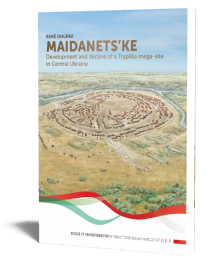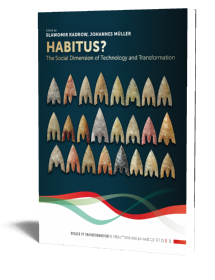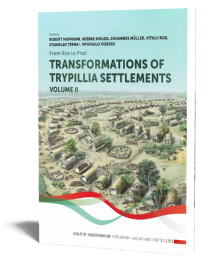From Ros to Prut (volume 1)
Transformations of Trypillia settlements
Edited by Robert Hofmann, Wiebke Kirleis, Johannes Müller, Vitalii Rud, Stanislav Ţerna†, Mykhailo Videiko | Forthcoming
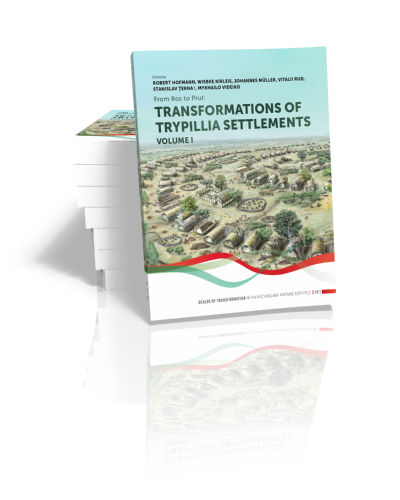
From Ros to Prut (volume 1)
Transformations of Trypillia settlements
Edited by Robert Hofmann, Wiebke Kirleis, Johannes Müller, Vitalii Rud, Stanislav Ţerna†, Mykhailo Videiko | Forthcoming
Paperback ISBN: 9789464270723 | Hardback ISBN: 9789464270730 | Imprint: Sidestone Press Academics | Format: 210x280mm | ca. 360 pp. | Scales of Transformation 19.1 | Series: Scales of Transformation | Language: English | 6 illus. (bw) | 151 illus. (fc) | Keywords: prehistoric archaeology; Trypillia; Chalcolithic; Mega-sites; Settlement Pattern; geophysics; geoarchaeology; archaeobotany; archeozoology; material culture; Ukraine | download cover | DOI: 10.59641/j9n462cl
Publication date: 28-03-2024
-
Digital & Online access
Digital/Online version not (yet) available
-
Buy via Sidestone (EU & UK)
Get €5.00 discount on forthcoming books by using coupon code "PRE-ORDER" in your shopping cart!
-
Buy via our Distributors (WORLD)
For non-EU or UK destinations you can buy our books via our international distributors. Although prices may vary this will ensure speedy delivery and reduction in shipping costs or import tax. But you can also order with us directly via the module above.
For UK & other International destinations
For USA/Canada & other International destinations
-
Bookinfo
Paperback ISBN: 9789464270723 | Hardback ISBN: 9789464270730 | Imprint: Sidestone Press Academics | Format: 210x280mm | ca. 360 pp. | Scales of Transformation 19.1 | Series: Scales of Transformation | Language: English | 6 illus. (bw) | 151 illus. (fc) | Keywords: prehistoric archaeology; Trypillia; Chalcolithic; Mega-sites; Settlement Pattern; geophysics; geoarchaeology; archaeobotany; archeozoology; material culture; Ukraine | download cover | DOI: 10.59641/j9n462cl
Publication date: 28-03-2024

We will plant a tree for each order containing a paperback or hardback book via OneTreePlanted.org.
Pre-dating the urban revolution in Western Asia, a network of agricultural settlements developed in the forest-steppe zone northwest of the Black Sea in the late 5th and first half of the 4th millennium BCE, some of which are among the largest prehistoric mega-sites in Europe. These enormous so-called Trypillia communities are unique in many respects, and the dynamics of their formation and their development have long been a topic of intensive research. For more than ten years now, research on the transformations of these Chalcolithic societies has been conducted as a Ukrainian-Moldavian-German cooperation. This research does not only focus on some of the largest mega-sites, but also attempts to reconstruct the dynamics of mega-site processes and their economic, social and ideological foundations in different perspectives – local, regional and interregional. Although our research is not yet complete, it is already clear that the emergence of Trypillia mega-sites represented the preliminary culmination of a regionally differentiated and widely interconnected process of settlement formation in the area between the Prut and Ros rivers. These processes were, on the one hand, closely interwoven with Copper Age societies of Southeast Europe and, on the other hand, ushered in the transition to the era characterised by higher settlement mobility.
This volume brings together archaeological, geophysical, archaeobotanical, archaeozoological and geoarchaeological contributions on economy, settlement patterns, material culture and dating from three different test regions in the territory of present-day Ukraine and Moldova. The presentation of our new data contributes decisively to a better understanding of both the enormous variability of settlement trajectories characterising this vast area and to connecting developments throughout time.
Volume 1 contains contributions on the Maidanetske mega-site and the Sinyukha River basin (Dnieper-southern Bug interfluve).
TRYPILLIA RESEARCH DECOLONISATION
1. Modern Trypillia Transformation research: decolonising by new research concepts, methods and results
Johannes Müller
MAIDANESTSKE AND SINYUKHA REGION (REGION A)
2. Report on the fieldwork of 2016 in the Trypillia mega-settlement Maidanetske: Investigations on the development and internal structuring
Robert Hofmann, Johannes Müller, Wiebke Kirleis, Michail Videiko, Hans-Rudolf Bork, René Ohlrau, Natalia Burdo, Liudmyla Shatilo, Vitalii Rud, Stefan Dreibrodt, Knut Rassmann, Masha Videiko
3. Geophysical Investigations at Maidanetske
Natalie Pickartz, Tina Wunderlich, Erica Corradini, Knut Rassmann, Dennis Wilken, Wolfgang Rabbel
4. Geoarchaeological analyses on daub pieces from Maidanets`ke- A treatises to reconstruct burning temperatures of houses and daub processing
Stefan Dreibrodt, Sarah Martini, Robert Hofmann, Marta Dal Corso, Wiebke Kirleis, Johannes Müller
5. The geoarchaeological record of the Chalcolithic Trypillian mega-settlement Maidanetske, central Ukraine
Stefan Dreibrodt, Sarah Martini, Robert Hofmann, Marta Dal Corso, Wiebke Kirleis, Johannes Müller
6. Is that all there is? The worked osseous materials from the site of Maidanetske
Andrea Ţerna
7. Plant economy and local environment at the Trypillia mega-site Maidanetske after botanical macro-remains
Marta Dal Corso, Wiebke Kirleis
8. X-Ray micro computer tomography (XRay-µCT) as a fast noninvasive technique for compositional studies of burned prehistorical materials- Results and implications from burned daub at Maidanetske, central Ukraine
Stefan Dreibrodt, Christopher Heilmann, Marta Dal Corso, Pia Bodden, Robert Hofmann, Michail Videiko, Johannes Müller, Wiebke Kirleis, Astrid Holzheid
9. Archaeozoological and taphonomic examinations carried out on faunal remains from Ukrainian-German excavations at Maidanetske from 2013 to 2016
Norbert Benecke, Robert Hofmann, Michail Videiko, Johannes Müller
10. The contribution of Chalcolithic terrestrial snail shells from Maidanetske to environmental reconstruction
Frank Schlütz, Marta Dal Corso, Wiebke Kirleis
11. Before Talyanok: large Trypilian sites built before the largest mega-settlements in the Sinyukha basin
Robert Hofmann, Liudmyla Shatilo
12. What was the significance of small Trypillia settlements? Report on a test excavation in Moshuriv 1, Sinyucha river basin, Ukraine
Robert Hofmann, Liudmyla Shatilo, Michailo Yu. Videiko
13. Trypillia mega-sites vicinity: the chronology of several small sites of the Southern Buh left bank region
Mykhailo Videiko, Vitalii Rud, Robert Hofmann, Vladyslav Chabaniuk
Dr. Robert Hofmann
Robert Hofmann is a researcher at the Institute for Prehistoric and Protohistoric Archaeology at Kiel University, Germany. After early beginnings in a school club of ‘young archaeologists’ and several years of working in a county archaeological research unit, he studied Prehistoric and Protohistoric Archaology at the Free University of Berlin between 1998 and 2005 (Magister 2005) and completed his PhD in 2011 at Kiel University.
Dr. Vitalii Rud
Vitalii Rud (1990) is a researcher at the Institute of Archaeology of the National Academy of Sciences of Ukraine, Department of Eneolithic and Bronze Age Archaeology. He has worked there since he was awarded his Master’s degree in Ancient History and Archaeology of Ukraine in 2012 at the National University of “Kyiv-Mohyla Academy”. In 2018 he was awarded a PhD for his thesis concerning Trypillia communities in the Dniester and Southern Bug interfluve in Ukraine in the beginning of IV mill. BC. Rud is also a researcher at the Department of Archaeology at Kyiv Borys Grinchenko University, and in 2018 he briefly worked at the Institute for Prehistoric and Protohistoric Archaeology at Kiel University, Germany.
Stanislav Ţerna†
Stanislav Țerna was a researcher at the “High Anthropological School” University, and previously at the Center for Archaeology, Institute of Cultural Heritage of the Moldovan Academy of Sciences, in Chișinău, Republic of Moldova. His area of research interest was the Copper Age of the north-west Black Sea region, focusing mainly on the settlement structure, anthropomorphic figurines, architecture and social organisation of the Cucuteni-Trypillia societies. He conducted excavations on LBK and Trypillia settlements in Moldova, of which the most important are those at Stolniceni I and Nicolaevca. He died in 2020, at the time when he was undertaking a PhD at the Institute of Prehistoric and Protohistoric Archaeology, Kiel University, within the CRC 1266 subproject “Population agglomeration at Tripolye-Cucuteni mega-sites”.

Prof. Dr. Wiebke Kirleis
Wiebke Kirleis is professor of environmental archaeology/archaeobotany at Kiel University, Germany. She is deputy director of the Collaborative Research Centre ‘Scales of Transformation: Human–Environmental Interaction in Prehistoric and Archaic Societies’ (CRC 1266, financed by the German Research Foundation/DFG) and a member of the Cluster of Excellence ‘Roots’ at Kiel University.
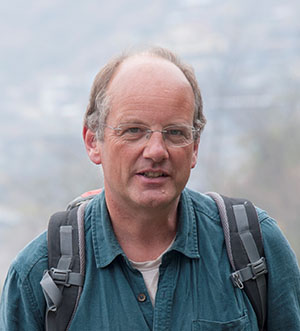
Prof. dr. Johannes Müller
Johannes Müller (PhD, University of Freiburg, 1990) is a Professor and Director of the Institute for Prehistoric and Protohistoric Archaeology at Kiel University, Germany. He is the founding director of the Johanna Mestorf Academy, Speaker of the Collaborative Research Centre “Scales of Transformation: Human-environmental Interaction in Prehistoric and Archaic Societies”and of the Excellence Cluster “ROOTS – Social, Environmental, and Cultural Connectivity in Past Societies”.
Prof. Dr. Mykhailo Videiko
Mykhailo Videiko is Professor at the Borys Grinchenko Kyiv University. His interests include the prehistory of Europe, archaeological manifestations of early urbanization, archaeology of Ukraine. He is the author of Ukraine: from Trypillia to Rus (2010), A comprehensive study of large settlements of the Trypillia Culture. V-IV millennia BC (2013), and South-Eastern and Central Europe in the V-IV millennia BC (2015), as well as co-editor (with N.Burdo and S.Liashko) of Encyclopedia of Trypillia civilization (2004), among other books. He has carried out fieldwork in Ukraine, Moldova and Poland.
Abstract:
Pre-dating the urban revolution in Western Asia, a network of agricultural settlements developed in the forest-steppe zone northwest of the Black Sea in the late 5th and first half of the 4th millennium BCE, some of which are among the largest prehistoric mega-sites in Europe. These enormous so-called Trypillia communities are unique in many respects, and the dynamics of their formation and their development have long been a topic of intensive research. For more than ten years now, research on the transformations of these Chalcolithic societies has been conducted as a Ukrainian-Moldavian-German cooperation. This research does not only focus on some of the largest mega-sites, but also attempts to reconstruct the dynamics of mega-site processes and their economic, social and ideological foundations in different perspectives – local, regional and interregional. Although our research is not yet complete, it is already clear that the emergence of Trypillia mega-sites represented the preliminary culmination of a regionally differentiated and widely interconnected process of settlement formation in the area between the Prut and Ros rivers. These processes were, on the one hand, closely interwoven with Copper Age societies of Southeast Europe and, on the other hand, ushered in the transition to the era characterised by higher settlement mobility.
This volume brings together archaeological, geophysical, archaeobotanical, archaeozoological and geoarchaeological contributions on economy, settlement patterns, material culture and dating from three different test regions in the territory of present-day Ukraine and Moldova. The presentation of our new data contributes decisively to a better understanding of both the enormous variability of settlement trajectories characterising this vast area and to connecting developments throughout time.
Volume 1 contains contributions on the Maidanetske mega-site and the Sinyukha River basin (Dnieper-southern Bug interfluve).
Contents
TRYPILLIA RESEARCH DECOLONISATION
1. Modern Trypillia Transformation research: decolonising by new research concepts, methods and results
Johannes Müller
MAIDANESTSKE AND SINYUKHA REGION (REGION A)
2. Report on the fieldwork of 2016 in the Trypillia mega-settlement Maidanetske: Investigations on the development and internal structuring
Robert Hofmann, Johannes Müller, Wiebke Kirleis, Michail Videiko, Hans-Rudolf Bork, René Ohlrau, Natalia Burdo, Liudmyla Shatilo, Vitalii Rud, Stefan Dreibrodt, Knut Rassmann, Masha Videiko
3. Geophysical Investigations at Maidanetske
Natalie Pickartz, Tina Wunderlich, Erica Corradini, Knut Rassmann, Dennis Wilken, Wolfgang Rabbel
4. Geoarchaeological analyses on daub pieces from Maidanets`ke- A treatises to reconstruct burning temperatures of houses and daub processing
Stefan Dreibrodt, Sarah Martini, Robert Hofmann, Marta Dal Corso, Wiebke Kirleis, Johannes Müller
5. The geoarchaeological record of the Chalcolithic Trypillian mega-settlement Maidanetske, central Ukraine
Stefan Dreibrodt, Sarah Martini, Robert Hofmann, Marta Dal Corso, Wiebke Kirleis, Johannes Müller
6. Is that all there is? The worked osseous materials from the site of Maidanetske
Andrea Ţerna
7. Plant economy and local environment at the Trypillia mega-site Maidanetske after botanical macro-remains
Marta Dal Corso, Wiebke Kirleis
8. X-Ray micro computer tomography (XRay-µCT) as a fast noninvasive technique for compositional studies of burned prehistorical materials- Results and implications from burned daub at Maidanetske, central Ukraine
Stefan Dreibrodt, Christopher Heilmann, Marta Dal Corso, Pia Bodden, Robert Hofmann, Michail Videiko, Johannes Müller, Wiebke Kirleis, Astrid Holzheid
9. Archaeozoological and taphonomic examinations carried out on faunal remains from Ukrainian-German excavations at Maidanetske from 2013 to 2016
Norbert Benecke, Robert Hofmann, Michail Videiko, Johannes Müller
10. The contribution of Chalcolithic terrestrial snail shells from Maidanetske to environmental reconstruction
Frank Schlütz, Marta Dal Corso, Wiebke Kirleis
11. Before Talyanok: large Trypilian sites built before the largest mega-settlements in the Sinyukha basin
Robert Hofmann, Liudmyla Shatilo
12. What was the significance of small Trypillia settlements? Report on a test excavation in Moshuriv 1, Sinyucha river basin, Ukraine
Robert Hofmann, Liudmyla Shatilo, Michailo Yu. Videiko
13. Trypillia mega-sites vicinity: the chronology of several small sites of the Southern Buh left bank region
Mykhailo Videiko, Vitalii Rud, Robert Hofmann, Vladyslav Chabaniuk
Dr. Robert Hofmann
Robert Hofmann is a researcher at the Institute for Prehistoric and Protohistoric Archaeology at Kiel University, Germany. After early beginnings in a school club of ‘young archaeologists’ and several years of working in a county archaeological research unit, he studied Prehistoric and Protohistoric Archaology at the Free University of Berlin between 1998 and 2005 (Magister 2005) and completed his PhD in 2011 at Kiel University.
Dr. Vitalii Rud
Vitalii Rud (1990) is a researcher at the Institute of Archaeology of the National Academy of Sciences of Ukraine, Department of Eneolithic and Bronze Age Archaeology. He has worked there since he was awarded his Master’s degree in Ancient History and Archaeology of Ukraine in 2012 at the National University of “Kyiv-Mohyla Academy”. In 2018 he was awarded a PhD for his thesis concerning Trypillia communities in the Dniester and Southern Bug interfluve in Ukraine in the beginning of IV mill. BC. Rud is also a researcher at the Department of Archaeology at Kyiv Borys Grinchenko University, and in 2018 he briefly worked at the Institute for Prehistoric and Protohistoric Archaeology at Kiel University, Germany.
Stanislav Ţerna†
Stanislav Țerna was a researcher at the “High Anthropological School” University, and previously at the Center for Archaeology, Institute of Cultural Heritage of the Moldovan Academy of Sciences, in Chișinău, Republic of Moldova. His area of research interest was the Copper Age of the north-west Black Sea region, focusing mainly on the settlement structure, anthropomorphic figurines, architecture and social organisation of the Cucuteni-Trypillia societies. He conducted excavations on LBK and Trypillia settlements in Moldova, of which the most important are those at Stolniceni I and Nicolaevca. He died in 2020, at the time when he was undertaking a PhD at the Institute of Prehistoric and Protohistoric Archaeology, Kiel University, within the CRC 1266 subproject “Population agglomeration at Tripolye-Cucuteni mega-sites”.

Prof. Dr. Wiebke Kirleis
Wiebke Kirleis is professor of environmental archaeology/archaeobotany at Kiel University, Germany. She is deputy director of the Collaborative Research Centre ‘Scales of Transformation: Human–Environmental Interaction in Prehistoric and Archaic Societies’ (CRC 1266, financed by the German Research Foundation/DFG) and a member of the Cluster of Excellence ‘Roots’ at Kiel University.

Prof. dr. Johannes Müller
Johannes Müller (PhD, University of Freiburg, 1990) is a Professor and Director of the Institute for Prehistoric and Protohistoric Archaeology at Kiel University, Germany. He is the founding director of the Johanna Mestorf Academy, Speaker of the Collaborative Research Centre “Scales of Transformation: Human-environmental Interaction in Prehistoric and Archaic Societies”and of the Excellence Cluster “ROOTS – Social, Environmental, and Cultural Connectivity in Past Societies”.
Prof. Dr. Mykhailo Videiko
Mykhailo Videiko is Professor at the Borys Grinchenko Kyiv University. His interests include the prehistory of Europe, archaeological manifestations of early urbanization, archaeology of Ukraine. He is the author of Ukraine: from Trypillia to Rus (2010), A comprehensive study of large settlements of the Trypillia Culture. V-IV millennia BC (2013), and South-Eastern and Central Europe in the V-IV millennia BC (2015), as well as co-editor (with N.Burdo and S.Liashko) of Encyclopedia of Trypillia civilization (2004), among other books. He has carried out fieldwork in Ukraine, Moldova and Poland.
-
Digital & Online access
Digital/Online version not (yet) available
-
Buy via Sidestone (EU & UK)
Get €5.00 discount on forthcoming books by using coupon code "PRE-ORDER" in your shopping cart!
-
Buy via our Distributors (WORLD)
For non-EU or UK destinations you can buy our books via our international distributors. Although prices may vary this will ensure speedy delivery and reduction in shipping costs or import tax. But you can also order with us directly via the module above.
For UK & other International destinations
For USA/Canada & other International destinations
- Browse all books by subject
-
Search all books

We will plant a tree for each order containing a paperback or hardback book via OneTreePlanted.org.
You might also like:
© 2025 Sidestone Press KvK nr. 28114891 Privacy policy Sidestone Newsletter Terms and Conditions (Dutch)
